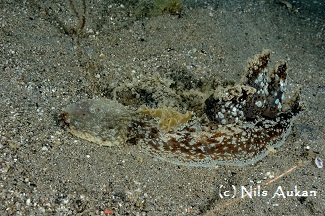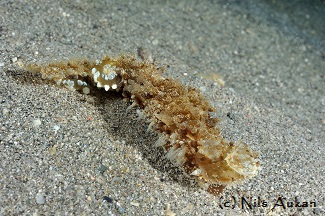Loading content - please wait...
Melibe viridis video from Gorontalo
Melibe viridis is a highly unusual nudibranch found throughout the Indo-Pacific region. It uses an oral hood like a net to capture live prey to eat.

A Camouflaged and Cumbersome Nudibranch
Imagine the surprise of divers to see a brownish mass twisting in the current over a muck diving site! That turned out to be a rarely seen Melibe viridis nudibranch. Viridis is a term describing young foliage. This is an apt description of a creature with parallel branches growing at spaced intervals and perpendicular to its body. Without movement
, this creature would blend perfectly into the coloration of the ocean bottom. Numerous bumps and tufts mark M. viridis distinctively. One diver captured these movements in a dramatic Melibe viridis video. This one measured about 8 cm long. Notice that its front left branch is stripped of its warty bark.On another day our divers found one measuring only two centimeters. This second M. viridis had somehow lost all its branches. Some had started growing back. However without those distracting cerata, divers could clearly see the way this nudibranch crawls on the long central foot. It leaves a mucous trail. This small one appears the second part of the video. Water that day was much greener than the previous day.
Watch this nudibranch twist its body and launch itself into the current. With twisting movements of its body, it succeeded in moving farther along the sloping sand bottom.
Melibe viridis Searching for Food
Melibe nudibranchs have a unique way of searching for food.They are active carnivores and use an oral hood. Imagine the divers’ further surprise to watch this nudibranch hunt for food.
In a rhythmical manner
, the nudibranch will cast its hood forward. On the inside edges of the oral hood, this type of nudibranch has short papillae, which sense movement. Sometimes, these are visible in the video. The Melibe tries to trap small crabs and shrimps its oral hood. Once trapped, the live prey gets dumped into the oral opening for consumption. The video clearly shows this unique way of hunting for food.
Worldwide, there are about 17 valid species of Melibe. Like other nudibranchs, Melibe are hermaphrodites. M. viridis grows up to 13 centimeters. Its color varies widely from light to dark, depending on the coloration of the substrate.
Only lucky divers will ever see a Melibe viridis searching for prey. However, for your chance to see one in Gorontalo, please book your dive trip with us.





